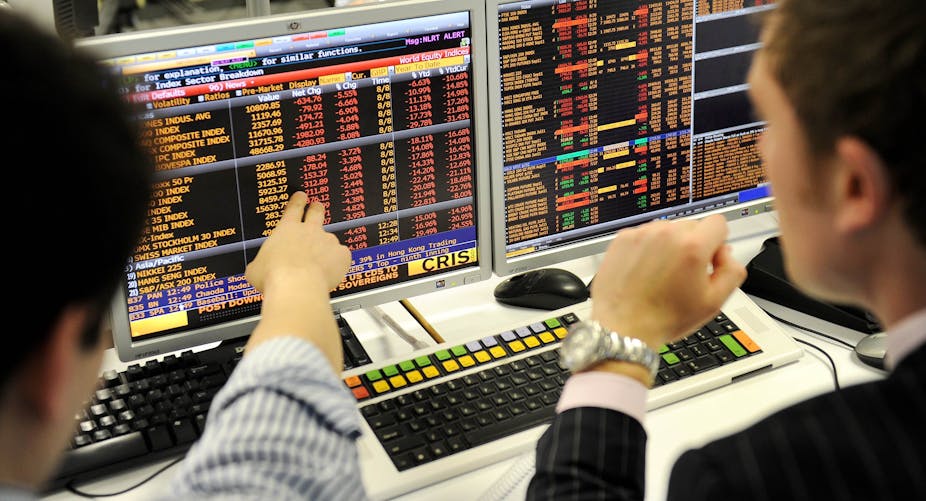After falling by almost 20% in week-long sell-off, the Australian share market has bounced back and began trade today up more than 3.5%.
The market’s recovery follows a strong comeback on Wall Street overnight, where shares had earlier been battered by negative sentiment about the global economy.
The Australian National University’s Geoff Warren explains what’s driving some of the biggest market swings in decades.
What is driving this volatility in the markets?
It’s always hard to know exactly what drives market fluctuations at any one point of time. Markets often seem to be reacting to particular news items. But what actually drives the movement can often be something deeper, such as shifts in portfolios or underlying structural trends.
One way to look at the market movements of the past few days is as follows. Prior to the sell-off there was a sense of complacency, a feeling that things would be OK in the global economy.
A couple of things have shocked the market out some of this complacency, leading to shifts in positions and expectations.
Sitting underneath this sell-off is a change in mood towards an element of underlying fear about the global economy. Recent economic data has been on the soft side. And on top of this there has been the realisation that, if significant problems do emerge, the amount of room to move on policy is somewhat limited in the major overseas economies. In sum, there a growing perception of downside risk.
This has caused the equity markets to sell off, and bond yields to drop as some people unwind positions and the markets re-price. Fears have been fed by the Standard & Poor’s downgrade of US debt and concerns over sovereign debt in Europe, but these might be better seen as catalysts rather than real core events. The real core event here is a shift in expectations about the outlook in the global economy.
The Australian sharemarket has started the day significantly higher after closing ahead last night, and there were strong gains on Wall Street overnight. What’s driving the comeback?
This is just the way markets operate. Markets don’t move in a straight line – they move in a zig-zag pattern. When you have a very big fall the market, some see it as a buying opportunity. The reason the market is bouncing back is not because certainty or confidence has returned, but because some people think that the market has become too cheap. That is, they see it as opportunity to buy in because the market is oversold.
I don’t think I’ve read any commentator who hasn’t admitted that there are still uncertainties about the economy. But there is a certain class of investor who see the bad news as discounted in the market, and hence as a time to buy.
Those people would have made a lot of money in the past few days, wouldn’t they?
Yes, if they bought in at the bottom. Though a lot would have lost on the way down. For most investors what is happening is an adjustment in market prices, with some trading occuring at the margin.
How seriously should markets be taken as a measure of the economy more broadly?
They’re pretty good at signalling the health of the economy. Stock market indicies are included in the leading indicator series for a reason.
The stock market has traditionally been a pretty good indicator of what is going to happen in the economy well before the event. However, it’s not perfect. People make the joke that stock markets have predicted something like nine out of the past five recessions. Stock markets can move for a range of reasons, of which anticipation of a weak economy is one.
But on average it’s a pretty good leading indicator. When stock market falls precipitously and seemingly inexplicably – and you have a downward sloping yield curve in the fixed-income markets – those two things usually amount to a message that bad times are ahead for the economy.
Although we don’t have downward-sloping yield curve globally given very low policy rates in the US and elsewhere, the decline in bond yields is also consistent with the markets anticipating weakness in the world economy.
Overall, the markets seem to be telling us that things might get a bit nasty.
Given the heavy investment of superannuation funds in equities markets, are Australians more exposed to fluctuations in sharemarkets than investors in other countries?
To some extent that’s true, but the division seems to be more between the Anglo-Saxon world and the non-Anglo-Saxon world.
Equity weightings are relatively high in the US, the UK and Australia, although they have been trending down in the UK.
In Europe and Japan, funds tend to be more weighted towards fixed-income investments such as bonds.

